Samsung Galaxy Note 8.0 Review
by Anand Lal Shimpi on April 17, 2013 11:29 PM EST- Posted in
- Tablets
- Samsung
- Android
- Mobile
- Galaxy Note 8.0
GPU Performance
The GPU side of Samsung's Exynos 4 Quad is also powered by ARM, in this case we're talking about the Mali 400MP4. ARM's Mali 400 is also getting older, but when it arrived on the scene its performance was pretty respectable. To evaluate its performance, we turn to our recently expanded list of Android 3D benchmarks starting with 3DMark.
3DMark - Ice Storm
3DMark for Android features the Ice Storm benchmark and uses OpenGL ES 2.0. Ice Storm is divided into two graphics tests and a physics test. The first graphics test is geometry heavy while the second test is more pixel shader intensive. The physics test, as you might guess, is CPU bound and multithreaded. The overall score takes into account both graphics and physics tests. The benchmark is rendered to an offscreen buffer at 720p/1080p and then scaled up to the native resolution of the device being tested. This is a very similar approach we've seen by game developers to avoid rendering at native resolution on some of the ultra high resolution tablets. The beauty of 3DMark's approach here is the fact that all results are comparable, regardless of a device's native resolution. The downside is we don't get a good idea of how some of the ultra high resolution tablets would behave with these workloads running at their native (> 1080p) resolutions.
For these benchmarks we stuck with the default presets (720p, normal quality). I'm reporting the overall and physics scores here:
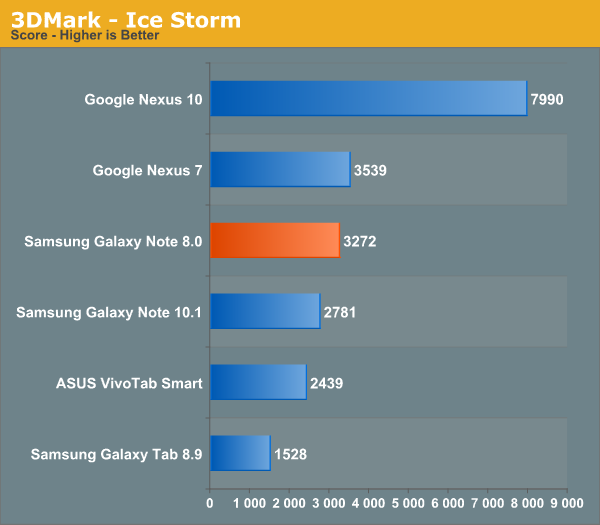
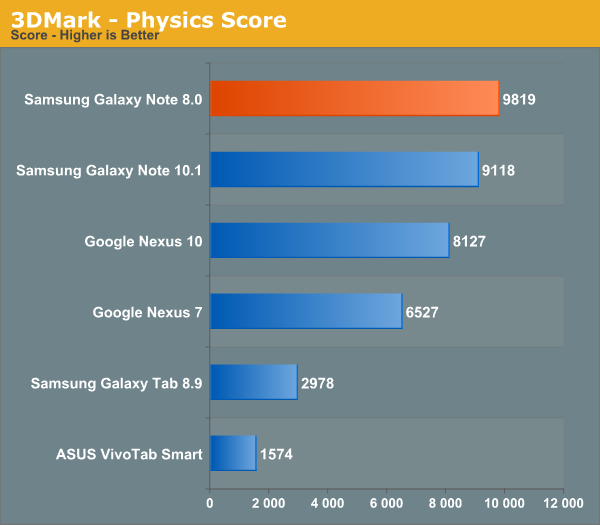
I tossed the physics test in here because it serves as an interesting multithreaded CPU benchmark. The results are largely unrealistic (a pair of Cortex A15s should almost always be quicker than four Cortex A9s at a lower frequency in most real world Android apps), but it does highlight the combination of core count and clock speed upgrades that we've seen over the past 2 years in the mobile tablet space.
Basemark X
Basemark X is a new addition to our mobile GPU benchmark suite. There are no low level tests here, just some game simulation tests run at both onscreen (device resolution) and offscreen (1080p, no vsync) settings. The scene complexity is far closer to GLBenchmark 2.7 than the new 3DMark Ice Storm benchmark, so frame rates are pretty low:
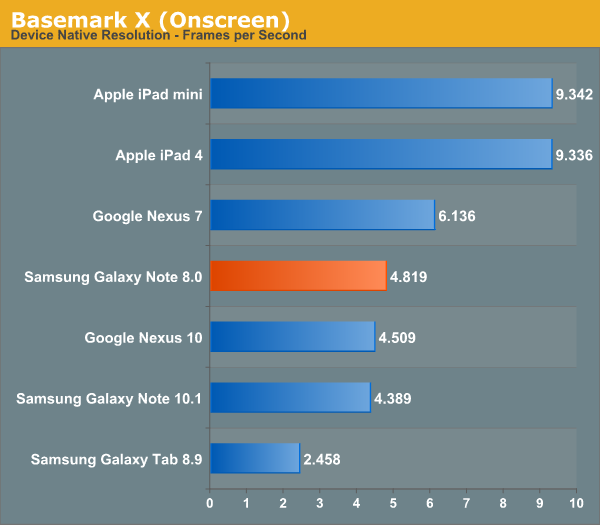
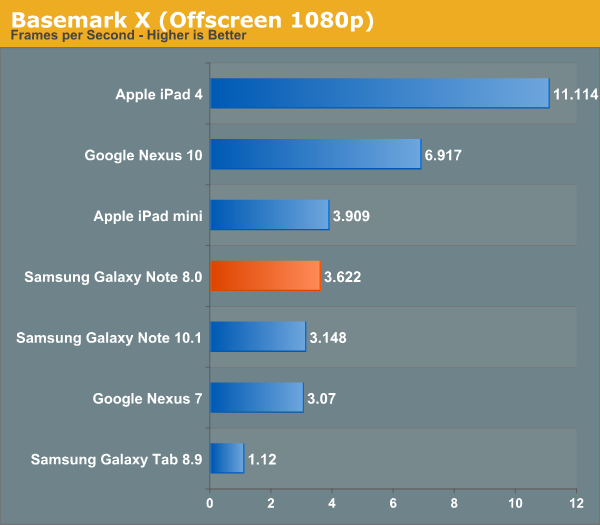
Basemark puts the Galaxy Note 8.0 behind the iPad mini in GPU performance and roughly 2 - 3x the performance of the Galaxy Tab 8.9.
GLBenchmark 2.7
GLBenchmark 2.7 gives us some low level results to look at. We'll start with peak theoretical fill rate and triangle throughput tests:

The Mali 400MP4 in the Galaxy Note 8.0 is capable of delivering similar fill rate to the PowerVR SGX 543MP2 in Apple's iPad mini, but the latter still holds an appreciable performance advantage. The gap between the 8.0 and 10.1 Galaxy Note models boils down to clock speeds. Compared to the old Galaxy Tab 8.9, the Note 8.0 puts its spiritual predecessor to shame.
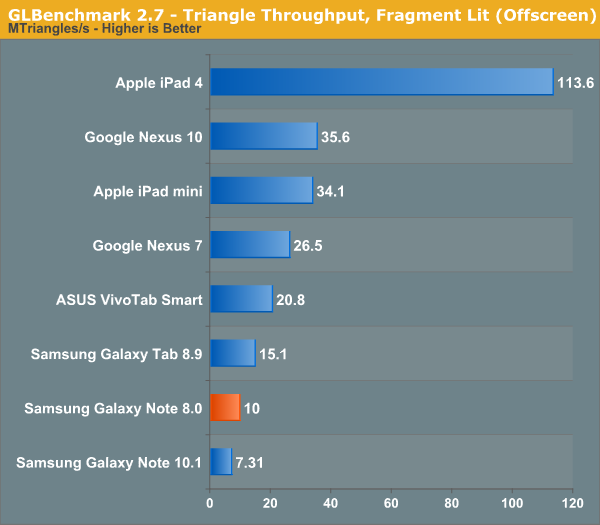
Can anyone say regression? ARM's Mali 400MP4 was never very strong from a triangle throughput standpoint, technically the Galaxy Tab 8.9 is quicker here (although you'll pretty much never see it surface in an actual game). The two GLBenchmark 2.7 test scenes follow:
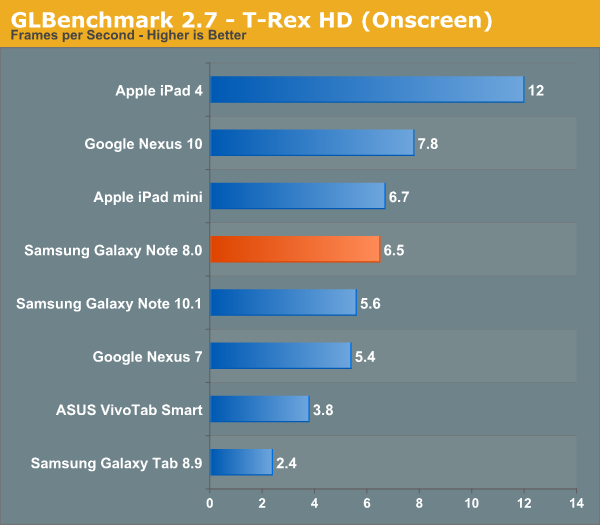

GLBench puts the Note 8's overall performance just slightly behind that of the iPad mini, and ahead of the mini if you compare identical workloads (offscreen 1080p). Obviously the GPU included here isn't anywhere near powerful enough to run the T-Rex HD workload at reasonable performance levels, but I wouldn't expect that to really hamper gaming performance for at least another two years.
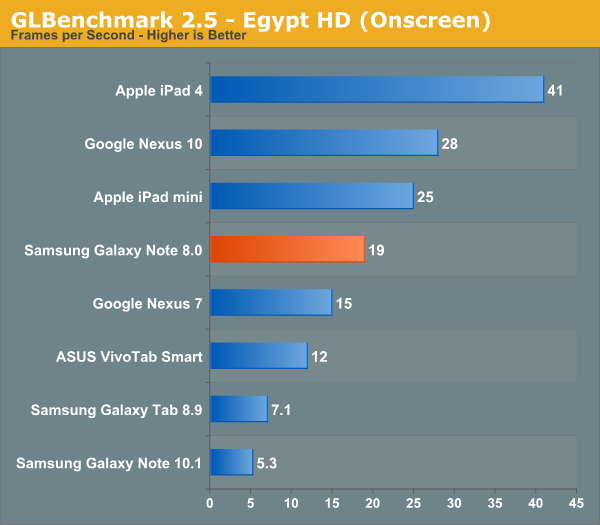
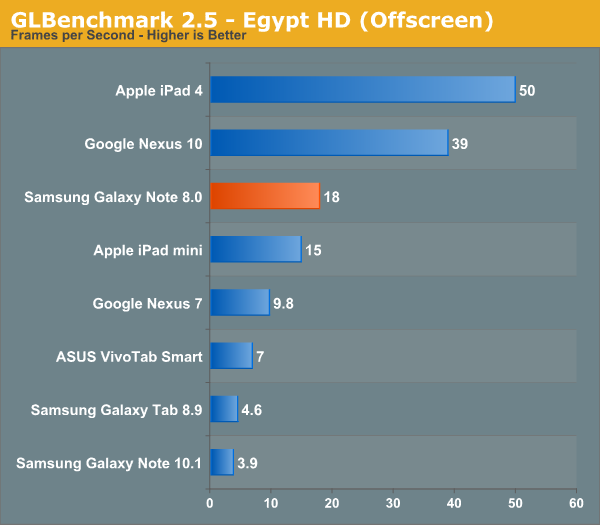
Egypt HD gives us a better look at what performance will look like in the near term. Once again, at native device resolution the iPad mini does better than the Note 8.0 but with the same workload/resolution their roles reverse. What we usually see, regardless of capabilities, is good real world performance by pretty much anything on the market. Most game developers seem to treat modern tablets like game consoles and attempt to deliver a good experience across the lowest common denominator rather than targeting the absolute high end.










95 Comments
View All Comments
danstek - Thursday, April 18, 2013 - link
I just have to say that the background used for the photos looks awesome!klatscho - Thursday, April 18, 2013 - link
just had the same thought - nice one anandhagmamad - Thursday, April 18, 2013 - link
stole the words out of my mouthonwudinjo,uzorchi - Wednesday, April 24, 2013 - link
hey guy checkout this page www.phy.unn.edu.ng for amazing information as regards academic excellencenerdstalker - Friday, April 19, 2013 - link
Hey, c'mon Anand... This is AnandTech, the gathering place of geeks and nerds. It's not The Verge. :Pmmartel - Saturday, April 20, 2013 - link
Another thumbs up on the photos - beautiful background and photography.nerdstalker - Sunday, April 21, 2013 - link
I bet the photos look awesome on an iPad 4/5, rMBP or late-2012 iMac. ;) BTW, for a long time I expected AnandTech to review the late-2012 iMacs; but it didn't happen. :( I hope they review, at least when those get the next speed bump.jeffkibuule - Thursday, April 18, 2013 - link
It's an interesting tablet for sure, but eh, we know we're going to get the Nexus 7 II with a 1920x1200 display and Qualcomm Snapdragon 600/800 in a month for $249-299. I'd just sit back and wait for the inevitable.thesavvymage - Thursday, April 18, 2013 - link
hell, it can keep the 1280x720 res if it stays at the 200/249 price point. Im just hoping the usb otg isnt totally neutered like it is on the Nexus 4. We shall see...MonkeyPaw - Thursday, April 18, 2013 - link
It's actually 1280x800, but I really hope Google doesn't overdo the specs of Nexus 7.2 and forsake battery life. More than anything, I wish my Nexus 7 got a few more hours on a charge, especially during games. I appreciate a boost in specs, but I hope they are sane about it.